 Black Soy Sauce (Nam Siew Dum) - Made from a Chinese recipe, this thick soy sauce can either be sweet or not. The thick sweet variety is used as noodle coloring, in Chinese-style cooking and dips. Denoted by a blue cap.
Black Soy Sauce (Nam Siew Dum) - Made from a Chinese recipe, this thick soy sauce can either be sweet or not. The thick sweet variety is used as noodle coloring, in Chinese-style cooking and dips. Denoted by a blue cap. 

 Herbs Commonly Used In Thai Cooking
Herbs Commonly Used In Thai Cooking 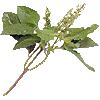
 Holy Basil (Bai Krapow) - The Thai equivalent of sweet basil, which can be used as a substitute if you cannot get holy basil. Ideally it should be used fresh, although it has worked well frozen. Suggested dish: Pad Prik Bai Krapow
Holy Basil (Bai Krapow) - The Thai equivalent of sweet basil, which can be used as a substitute if you cannot get holy basil. Ideally it should be used fresh, although it has worked well frozen. Suggested dish: Pad Prik Bai Krapow 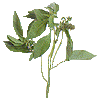
 Lemon Basil (Bai Mangrak) - The leaves have a smell redolent of citrus. Usually eaten raw as an accompaniment to curry. The seeds are first soaked and eatened either as a dessert with sweetened coconut milk or as a appetite suppresant.
Lemon Basil (Bai Mangrak) - The leaves have a smell redolent of citrus. Usually eaten raw as an accompaniment to curry. The seeds are first soaked and eatened either as a dessert with sweetened coconut milk or as a appetite suppresant. 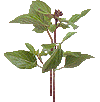
 Thai Basil (Bai Horapha) - Used in curries and with steamed mussels. Leaves have strong anise smell. Also known as cinnamon basil. Suggested dish: Hoi Op/Steamed Mussels
Thai Basil (Bai Horapha) - Used in curries and with steamed mussels. Leaves have strong anise smell. Also known as cinnamon basil. Suggested dish: Hoi Op/Steamed Mussels 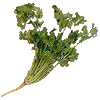
 Cilantro (Pak Chee) - The root is used in curry pastes and marinade. The plant is used as garnish and flavoring, the seed for curry pastes. Suggested use: Chicken Cilantro
Cilantro (Pak Chee) - The root is used in curry pastes and marinade. The plant is used as garnish and flavoring, the seed for curry pastes. Suggested use: Chicken Cilantro 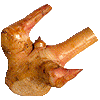
 Galangal (Kha) - A relative of the ginger, it looks somewhat like its cousin. The flavor is heavier than ginger, pungent. An ingredient of various curry pastes and a few other sauces.
Galangal (Kha) - A relative of the ginger, it looks somewhat like its cousin. The flavor is heavier than ginger, pungent. An ingredient of various curry pastes and a few other sauces. 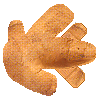
 Ginger (Khing) - In Thai cooking ginger root is used in variou dishes. Young ginger is often pickled and eaten on the side. Suggested dish: Kao Mungai/Rice Cooked in Chicken Fat
Ginger (Khing) - In Thai cooking ginger root is used in variou dishes. Young ginger is often pickled and eaten on the side. Suggested dish: Kao Mungai/Rice Cooked in Chicken Fat 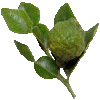
 Kaffir Lime (Magrut) - The leaves of this citrus plant (Bai Magrut) are used to flavor soups, curries, and other dishes. The fruit (Loog Magrut) is rarely available fresh outside of Thailand, its limited juice used as flavoring and a hair rinse.
Kaffir Lime (Magrut) - The leaves of this citrus plant (Bai Magrut) are used to flavor soups, curries, and other dishes. The fruit (Loog Magrut) is rarely available fresh outside of Thailand, its limited juice used as flavoring and a hair rinse. 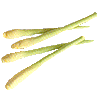
 Lemongrass (Thakrai) - Only the lower part of this plant is used, which smells like lemon. If used whole, crush to release aroma. If to be eaten sliced very thinly, taking care to remove the tough outer layers. Suggested dish: Tom Yum Goong
Lemongrass (Thakrai) - Only the lower part of this plant is used, which smells like lemon. If used whole, crush to release aroma. If to be eaten sliced very thinly, taking care to remove the tough outer layers. Suggested dish: Tom Yum Goong 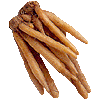
 Lesser Galangal (Krachai) - Long, thin brown roots with a pungent flavor. A main use for it is in Nam Ya, where it is a major flavoring agent after red curry.
Lesser Galangal (Krachai) - Long, thin brown roots with a pungent flavor. A main use for it is in Nam Ya, where it is a major flavoring agent after red curry. 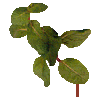
 Mint (Bai Sala Nae) - Used fresh mainly in spicy Northern salads (laabs).
Mint (Bai Sala Nae) - Used fresh mainly in spicy Northern salads (laabs).  Vegetables Commonly Used In Thai Cooking
Vegetables Commonly Used In Thai Cooking  Baby Corn (Kao Poad Orn) - Available fresh in Thailand but usually canned in the US. Used mainly in Chinese-style stir fries.
Baby Corn (Kao Poad Orn) - Available fresh in Thailand but usually canned in the US. Used mainly in Chinese-style stir fries. 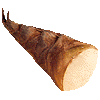
 Bamboo (Nor Mai) - In Thailand used fresh, pickled and dried. Good for stir fries, curries, Chinese-derived dishes and some streetside appetizers.
Bamboo (Nor Mai) - In Thailand used fresh, pickled and dried. Good for stir fries, curries, Chinese-derived dishes and some streetside appetizers. 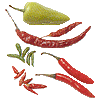
 Chili Peppers (Prik) - Two varieties are commonly used, the infamous Prik Kee Noo and the large, finger-length Prik Chee. The first chili is also known as Bird's Eye Chili and is frequently found in dips and eaten raw. The latter is used fresh and dried, added to curry pastes and pickled and used as a condiment.
Chili Peppers (Prik) - Two varieties are commonly used, the infamous Prik Kee Noo and the large, finger-length Prik Chee. The first chili is also known as Bird's Eye Chili and is frequently found in dips and eaten raw. The latter is used fresh and dried, added to curry pastes and pickled and used as a condiment.  Bitter Melon (Mara) - Used in Chinese-derived cooking. Simply boiled with chicken or pork and pickled mustard to tone down bitterness. Stuffed with flavored ground pork and boiled in broth. Thinly sliced and blanched and served with Nam Ya.
Bitter Melon (Mara) - Used in Chinese-derived cooking. Simply boiled with chicken or pork and pickled mustard to tone down bitterness. Stuffed with flavored ground pork and boiled in broth. Thinly sliced and blanched and served with Nam Ya.  Chinese Broccoli (Pak Kana) - A leafy green vegetable similar in looks to collard greens but not the Western broccoli. Has the taste and texture of the broccoli. Suggested dish: Pad Sieu
Chinese Broccoli (Pak Kana) - A leafy green vegetable similar in looks to collard greens but not the Western broccoli. Has the taste and texture of the broccoli. Suggested dish: Pad Sieu  Chinese Chive (Thon Gui Chai) - Flatter, longer leaves with a more pungent taste than regular chives. The Chinese use it in Steamed Rice Cakes with Chinese Chive stuffing. Not too commonly used, but can be found in traditional Pad Thai .
Chinese Chive (Thon Gui Chai) - Flatter, longer leaves with a more pungent taste than regular chives. The Chinese use it in Steamed Rice Cakes with Chinese Chive stuffing. Not too commonly used, but can be found in traditional Pad Thai . 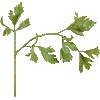
 Chinese Celery (Pak Chee Lom) - Stronger and slender version of the western celery. Mostly used as an herb to flavor soup, rice or noodle dishes.
Chinese Celery (Pak Chee Lom) - Stronger and slender version of the western celery. Mostly used as an herb to flavor soup, rice or noodle dishes.  Cucumber (Thang Gwa) - Used as a side, a salad or boiled in soups. Thai cucumbers are more like pickling cucumbers in size and shape. Suggested dish: Gang Jerd
Cucumber (Thang Gwa) - Used as a side, a salad or boiled in soups. Thai cucumbers are more like pickling cucumbers in size and shape. Suggested dish: Gang Jerd 
 Thai Eggplant (Makreu Poh) - The most commonly used eggplant in Thailand. About the size of a large golf ball - creamy white with light green striping. Is eaten raw as a side or used in curries.
Thai Eggplant (Makreu Poh) - The most commonly used eggplant in Thailand. About the size of a large golf ball - creamy white with light green striping. Is eaten raw as a side or used in curries.  Long Eggplant (Makreua Yao) - Long, thin and green, unlike the large purple variety used in the West. Japanese eggplant is a good substitute. Mainly found in stir fries.
Long Eggplant (Makreua Yao) - Long, thin and green, unlike the large purple variety used in the West. Japanese eggplant is a good substitute. Mainly found in stir fries.  Pea Eggplant (Makreua Puang) - Rarely used, but found in curries. Small green fruits in a grape-like cluster.
Pea Eggplant (Makreua Puang) - Rarely used, but found in curries. Small green fruits in a grape-like cluster. 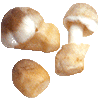
 Straw Mushroom (Het Fang) - Available fresh in Thailand (beautifully large), but canned in the West. Used in soups and stir fries.
Straw Mushroom (Het Fang) - Available fresh in Thailand (beautifully large), but canned in the West. Used in soups and stir fries. 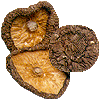
 Shiitake Mushroom (Het Horm) - Used in its dried form in Thailand, but available fresh in the West. Has a strong aroma when dried, reconstitute before use. Suggested dish: Pla Neung
Shiitake Mushroom (Het Horm) - Used in its dried form in Thailand, but available fresh in the West. Has a strong aroma when dried, reconstitute before use. Suggested dish: Pla Neung 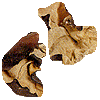
 Cloud's Ear Mushroom (Het Hoo Noo) - Adds crunch to stir fries and salads. Available dried in the West, reconstitute before use.
Cloud's Ear Mushroom (Het Hoo Noo) - Adds crunch to stir fries and salads. Available dried in the West, reconstitute before use. 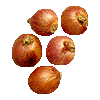
 Shallot (Hom Lek) - Milder and smaller version of the onion. Shallots are commonly used in making curry pastes and in salads.
Shallot (Hom Lek) - Milder and smaller version of the onion. Shallots are commonly used in making curry pastes and in salads.  Daikon (Hua Pak Gard Kao) - In Thai cooking it's used in soups and curries as well as a fried savory cake with peanuts.
Daikon (Hua Pak Gard Kao) - In Thai cooking it's used in soups and curries as well as a fried savory cake with peanuts. 
 Banana Flower (Huaplee) - The unopened blossom of the banana plant is eaten as a vegetable. It is usually sliced thinly and blanched before serving as a side for curries.
Banana Flower (Huaplee) - The unopened blossom of the banana plant is eaten as a vegetable. It is usually sliced thinly and blanched before serving as a side for curries. 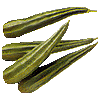
 Sponge Gourd (Buap) - Thin, dark green spongy gourd with ridges that needs to be peeled. Used mainly in stir fries.
Sponge Gourd (Buap) - Thin, dark green spongy gourd with ridges that needs to be peeled. Used mainly in stir fries.  Water Morning Glory (Pak Bung) - A quick stir fry at high heat is how you make the infamous Pak Bung Fai Dang. Also used in my all-time favorite dish as a filler - Yen Ta Fo.
Water Morning Glory (Pak Bung) - A quick stir fry at high heat is how you make the infamous Pak Bung Fai Dang. Also used in my all-time favorite dish as a filler - Yen Ta Fo.  Winged Bean (Tua Phu) - Used to be a rarity in the US, but now makes its appearance every so often, or at least here in Florida. Light green foot-long bean with frills on the sides. One use is in a salad.
Winged Bean (Tua Phu) - Used to be a rarity in the US, but now makes its appearance every so often, or at least here in Florida. Light green foot-long bean with frills on the sides. One use is in a salad.  Wax Gourd (Fak Kieo) - Size of a luffa gourd, with waxy green skin. Used in soups, curries and stir fries.
Wax Gourd (Fak Kieo) - Size of a luffa gourd, with waxy green skin. Used in soups, curries and stir fries.  Yard Long Bean (Tua Yao) - Actually a foot and a half, but not a yard. Green beans can be substituted. Used in stir fries, at least one curry, eaten raw as a side, and adds crunch to Tod Mun. Suggested dish: Pad Ped Tua Fak Yao
Yard Long Bean (Tua Yao) - Actually a foot and a half, but not a yard. Green beans can be substituted. Used in stir fries, at least one curry, eaten raw as a side, and adds crunch to Tod Mun. Suggested dish: Pad Ped Tua Fak Yao  Common Flavoring Agents Found In Thai Cooking
Common Flavoring Agents Found In Thai Cooking  Fish Sauce (Nam Pla) - Thai fish sauce is a clear salty brown liquid made from fermented anchovies, salt and water. Used in just about every entree in Thai cuisine, it amazingly does not add too fishy a taste. Common brands are Tiparos, Oyster and Squid.
Fish Sauce (Nam Pla) - Thai fish sauce is a clear salty brown liquid made from fermented anchovies, salt and water. Used in just about every entree in Thai cuisine, it amazingly does not add too fishy a taste. Common brands are Tiparos, Oyster and Squid.
 Black Soy Sauce (Nam Siew Dum) - Made from a Chinese recipe, this thick soy sauce can either be sweet or not. The thick sweet variety is used as noodle coloring, in Chinese-style cooking and dips. Denoted by a blue cap.
Black Soy Sauce (Nam Siew Dum) - Made from a Chinese recipe, this thick soy sauce can either be sweet or not. The thick sweet variety is used as noodle coloring, in Chinese-style cooking and dips. Denoted by a blue cap.
 White Soy Sauce (Nam Siew Kao) - Thin Chinese soy sauce, much thinner than Japanese soy sauce and lighter in taste. Denoted by a white cap.
White Soy Sauce (Nam Siew Kao) - Thin Chinese soy sauce, much thinner than Japanese soy sauce and lighter in taste. Denoted by a white cap.
 Siracha Hot Sauce - Thick, sweet hot sauce. I like it on my Thai omelet.
Siracha Hot Sauce - Thick, sweet hot sauce. I like it on my Thai omelet.
 Golden Mountain Sauce - Another soy sauce, but very aromatic, somewhat like Magi Sauce.
Golden Mountain Sauce - Another soy sauce, but very aromatic, somewhat like Magi Sauce.
 Oyster Sauce (Nam Mun Hoi) - Oyster flavored sauce thicken with corn starch and used in stir fries.
Oyster Sauce (Nam Mun Hoi) - Oyster flavored sauce thicken with corn starch and used in stir fries.
 Shrimp Paste (Kapi) - Paste made from small shrimps and salt, pounded into a paste, fermented and dried. Toast slightly before use to give a warm aroma. Used in curry pastes, sauces, and a royal fried rice dish.
Shrimp Paste (Kapi) - Paste made from small shrimps and salt, pounded into a paste, fermented and dried. Toast slightly before use to give a warm aroma. Used in curry pastes, sauces, and a royal fried rice dish.
 Vinegar (Nam Som) - White vinegar used in side salads and in Sweet & Sour.
Vinegar (Nam Som) - White vinegar used in side salads and in Sweet & Sour.
 Yellow Bean Sauce (Thow Jiaw) - A bottled sauce made from fermented soy beans. Used in Lad Na and stir fries. The Chinese variety is a good substitute, but the Thai variety is widely available.
Yellow Bean Sauce (Thow Jiaw) - A bottled sauce made from fermented soy beans. Used in Lad Na and stir fries. The Chinese variety is a good substitute, but the Thai variety is widely available.
 Miscellaneous Items in Thai Cooking
Miscellaneous Items in Thai Cooking
 Noodles
Noodles
Rice Noodles (Guoi Thieu) - Usually sold dried in Oriental markets and must be reconstituted. Comes in different widths - wide, medium, thin, vermicelli. Recommended dish: Lad Na
Ramen (Ba Mee) - The Thais eat Chinese style ramen versus the Japanese variety. Ramen is sold fresh or dried in fist-size bundles that are given a quick dip in hot water before serving. Made from wheat flour and egg (thus the yellow color). Recommended dish: Ba Mee Moo Dang (Red Pork Ramen)
Somen (Kanom Jeen) - The Japanese somen is the best substitute in the West. The rice flour dough of kanom jeen is first fermented a little before being processed into noodle form. This gives the noodle a distinctive flavor when served with curries. Sold fresh in Thailand in large plaited baskets separated with banana leaves. Recommended dish: Nam Ya
Cellophane Noodles (Wun Sen) - Made from mung beans, this clear noodle is sold in little bundles. Soak before use and add toward the end of the cooking process. Over-cooking will cause the noodle to get mushy. Used in soups, stir-fries and salads. Recommended dish: Yum Wun Sen
 Chinese Sausage (Guang Chiang) - Air dried pork sausage that is reddish in appearance and sweet/salty when cooked. Chinese sausage is always used in cooking and not eaten raw. Recommended dish: Kao Pad
Chinese Sausage (Guang Chiang) - Air dried pork sausage that is reddish in appearance and sweet/salty when cooked. Chinese sausage is always used in cooking and not eaten raw. Recommended dish: Kao Pad
 Dried Salted Radish (Hua Chai Po) - Dried salted daikon, quite unlike the Japanese daikon pickle takuan. Give it a quick rinse before using. Recommended dish: Pad Thai
Dried Salted Radish (Hua Chai Po) - Dried salted daikon, quite unlike the Japanese daikon pickle takuan. Give it a quick rinse before using. Recommended dish: Pad Thai
 Back to Shrubbery's Kitchen
Back to Shrubbery's Kitchen  E-mail comments & questions
E-mail comments & questions